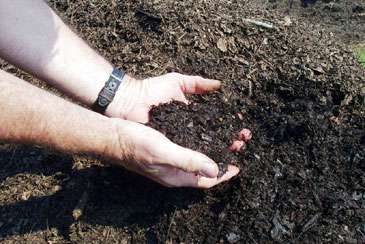Landscaping with a Green Thumb: Composting

In this article, you will find:
Starting the pile
Creating an EnclosureIn theory, you don't need any sort of enclosure or bin for your compost—it will happen just fine without one. However, the pile will look better and be easier to manage with a three-sided enclosure made of fencing, wood, or cement blocks. Leave openings in the walls of the enclosure to allow air in. The fourth, open side will give you easy access to the entire pile, so you can turn the materials in the pile and extract the finished compost. A bin no larger than 4'x4'x4' is recommended. If you have the room, set up a second bin next to the first—that way you can shift undecomposed materials easily to get to the finished compost.
Of course, you can purchase a compost bin or system from any number of websites and garden centers. Many of these have a locking lid, which prevents animals from foraging and helps to keep down odor. If you live in an urban area, check with your DPW to see whether they offer subsidized bins.
What to Compost
If you start a compost pile in the spring, you'll have all of the warm months to get it cooking. But except for the dead of winter, when little decomposition takes place, you can start a pile in any season.
You should aim for a 25:1 ratio of carbon-rich materials ("browns") to nitrogen-rich materials ("greens"). Too much carbon will slow down decomposition, and too much nitrogen can lead to odor. You can roughly judge the ratio by the weight of the materials. Here's just a partial list of things that can go into the pile:
- All kitchen waste except meat, bones, fish, dairy, and high fat foods (e.g., peanut butter) and oils. Meat, fish, and fatty materials will smell and will attract pests.
- Coffee grounds, paper filters, and tea bags.
- Paper and cardboard—cut or tear into small pieces.
- Wood ashes—note that they are alkaline, which is helpful for acid soils. Do not add the ashes from coal or charcoal briquettes.
- Grass clippings that are free of pesticides and herbicides.
- Pine needles—note that they are acidic, which can help alkaline soils. Chop or shred them to help them break down.
- Manure from any animal except meat-eating animals—their waste may contain pathogens. Also forgo bird droppings.
- Shredded leaves of all kinds, except leaves from eucalyptus and black walnut trees, which are toxic.
- Seaweed—wash the salt off well with a hose before adding seaweed to the pile.
Do not put diseased plants, poison oak, poison ivy, or sumac in the pile. It's also a good idea to dry out weeds on the pavement before adding them.

